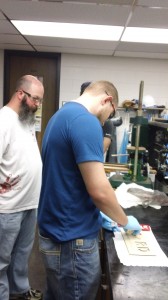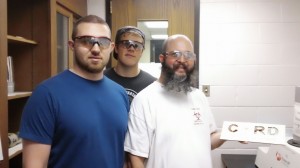Solar panels from a can? It could be possible in the future
The days of big, bulky solar panels made of breakable ceramic may be over if Dr. Brian Cavitt has anything to do with it.
Dr. Cavitt and his two research assistants, Barret Davidson and Sam Gee, have been conducting research to discover a compound that will absorb ultraviolet (UV) light. Specifically, Dr. Cavitt’s team is seeking a compound that will absorb UV light when bonded with clay. Such a reaction will result in a nanocomposite material that is usable in electronics like solar panels and has other possible applications such as dental repairs. The technology can even be used with food packaging.
“After my related presentation at an international conference in May,” Dr. Cavitt said, “a representative from a major packaging company approached me and asked if our product could be used to coat paper and potentially replace the aluminum insert in cigarette packs. I confirmed that indeed our product can coat paper and protect the contents, even cigarettes, from atmospheric water and oxygen which can reduce the freshness of an agricultural product.”
Though neither Barret nor Sam plan to work in chemistry labs upon graduation, the experience they are gaining this summer working on Dr. Cavitt’s research project does carry over to their future plans.
Sam plans to go to law school and specialize in patent law and intellectual property.
“Anytime a new product is synthesized, it will need legal protection so the scientist’s work is not stolen,” Sam said. “Patent attorneys specialize in this, and the experience I’ve gained through research in Dr. Cavitt’s lab has given me a significant amount of research experience. After I go through law school, I will have experience in both the research and legal areas, which will more fully prepare me for a career in patent and intellectual property law.”
Barret plans to go to dental school. Using UV light in dentistry is current practice, and Dr. Cavitt’s research has possible future applications in dentistry.
“My current goal is to get accepted into dental school, and doing this research will help me do that. After this year I will have over 200 lab hours working with photo initiators, which are used in dentistry, and this will help me stand apart from the other applicants without research experience. It will also help me in dental school with better lab techniques and practices,” Barret said.
Dr. Cavitt concurred with Barret that the use of UV lighting in the lab will give Barret an advantage when applying for dental school.
“Dental composites for fillings use a similar technology. Our clay nanocomposite could make a better – and cheaper – dental composite. After all, our material is dirt cheap!” Cavitt said.
Because of ACU internal grants, Dr. Cavitt has been able to carry out research that would not have been possible otherwise.
“Internal grant funding has largely empowered my research throughout my 12 years at ACU. It’s helped lead to multiple publications, presentations, two patent applications, and a plethora of mentoring opportunities. For the internal grant funding, I’m extremely thankful,” Cavitt said.
”